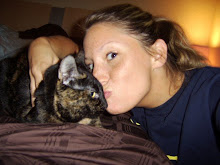Animal Adaptations This project has not been introduced to the class so if you are a blog-checker, you are getting a sneak peak!
This project will count the same as 2 test grades. It is due on Thursay, March 20.
All animals live in habitats. Habitats provide food, water, and shelter which animals need to survive, but there is more to survival than just the habitat. Animals also depend on thier physical features to help them obtain food, keep safe, build homes, withstand weather, and attract mates. These physical features are called physical adaptations. hysical adaptations do not develop during an animal's life but over many generations. The shope of a bird's beak, the number of fingers, color of the fur, the thickness or thinness of the fur, or the shape fo the nose or ears are all examples fo physical adaptations which help different animals to survive.
Sample the internet sites given about animal adaptations and complete the activities for each one. You may also use other sites or books as well. If you do onot have access to a computer at home, visit your public library, use a classroom computer during study hall, or check out books at teh library. You must include a picture of each animal and write a paragraph that answers the questions for each animal chosen. You must choose 15 different animals in your project. The project should be assembled in a folder and should be av ery neat presentation. Include a cover page with the title of the project, your name, date, and class period.
This project will be due on Thursday, March 20th. Please share this information with your parents. Happy Hunting!
Burmese Python: http://www.whozoo.org/students/stamoo/pythonhtml.html
How are the mouths of pythons adapted to finding prey and swallowing large prey?
White-cheeked Gibbon: http://www.lpzoo.org/animals/factsheet/phpcontentID=162
Why do many monkeys and apes have long arms?
Describe special adaptations on the hands of gibbons.
South African Burrowing Bullfrog: http://www.oaklandzoo.org/meet_the_animals/south-african-burrowing-bulfrog*
What do they eat?
How do they hold on to prey that is struggling to escape?
California King Snake: http://www.oaklandzoo.org/meet_the_animals/california-kind-snake*
Why can king snakes eat rattle snakes?
Beaver Facts: http://www.wildlife.alaska.gov/index.cfm?adfg=funfacts.beaver
How are beavers built for underwater work?
This site has additional information.
White Throated Savanna Monitor: http://www.oaoklandzoo.org/meet_the_animals/white-throated-monitor
How long are they?
What do they eat?
How are their mouths adapted to what they eat?
Giraffe: http://www.oaklandzoo.org/meet_the_animals/giraffe,-reticulated
Why are giraffes able to go for long periods of time without water?
How are their necks adapted to their lifestyle?
African Hedgehog: http://www.awf.org/content/wildlife/detail/hedgehog
Besides having stiff spines that stick out from their bodies and help protect them, these animals have loose skin under those spines and powerful back muscles. Why?
Kratt's Creatures: http://pbskids.org/krattscreatures/login.shtml?
From this page, click on "North America" and then click on "American alligator"
How are these alligoator's eyes adapted for seeing in water?
Lions: http://www.lpzoo.org/animals/LION-HOUSE/index.html
What is the purpose of the mane on a male lion?
Why are the eyes of a lion set in the front of its head rather than on the sides?
A lion has heavily muscled forelimbs and shoulders. Why?
Why do they have forepaws equipped with long, retractile claws?
Why do they have a rough tongue?
Why do othey have loose belly skin?
Bactrian Camel: http://www.lpzoo.org/animals/factsheet.php?contentID=196
Camels have many adaptations that allow them to live successfully in desert conditions. List these adaptations and how they benefit the camel.
Koala: http://www.seaworld.org/animal-info/animal-bytes/animalia/eumetazoa/coelomates/deuterostomes/chordata/craniata/mammalia/diprotodontia/koala.htm
How are the hands of a koala adapted for life in a tree?
Sea Otters: http://www.mnh.si.edu/arctic/html/sea_otter.html
Sea Otters spend almost their entire lives in water. They eat, sleep, and even have their babies in water. how is their fur adapted to keep them warm? Why is it a critical situation when otters encounter oil spills?
What do they eat?
Lappet-faced Vulture: http://www.thebigzoo.com/Animals/Lappet-faced_Vulture.asp
How are the heads of vultures adapted to what they eat?
Manatees: http://www.savethemanatee.org/faq.htm
Scroll down about 1/3 of the way down the page. What special adaptations do manatees have that allow them to stay under water longer than teh average land-dwelling mammal?
Wallaroo: http://www.australianstamp.com/Coin-web/feature/nature/commwall.htm
What do they eat?
How are their feet adapted to rock climbing?
Polar Bears: http://www.mng.si.edu/arctic/html/polar_bear.html
Why do polar bears have such big feet?
How does their fur keep them warm?
Kratt's Creatures: http://pbskids.org/krattscreatures/login.shtml?
From this page, click on "Australia" and then click on "Platypus".
How are platypuses adapted for the time they spend in water?
Kratt's Creatures: http://pbskids.org/krattscreatures/login.shtml?
From this page, click on "Oceans" and then click on "Pacific walrus".
What special adaptation do these walruses have that allow them to float on top fo the water and sleep?
Squirrel Monkey: http://www.oaklandzoo.org/meet_the_animals/squirrel-monkey
Where in the world do they live?
What do they eat?
These monkeys live in groups. How does this help them?
Kratt's Creatures: http://pbskids.org/krattscreatures/login.shtml?
From this page, click on "North America" and then click on "Mountain goat".
How are they adapted for living in the tops of high, cold mountains?
How are their rear ends adapted to protect themselves from other goats?
Gila Monster: http://www.scz.org/animals/g/gila.html
What do gila monsters do oto avoid the heat of the day?
What do gila monsters do in winter months to keep warm? How do othey survive during winter months with little food?
Red Panda: http://www.enchantedlearning.com/subjects/mammals/redpanda/Redpandaprintout.shtml
How are red pandas adapted to eating bamboo?
Kratt's Creatures: http://pbskids.org/krattscreatures/login.shtml?
From this page, click on "Eurasia" and then click on "Snow Leopard".
How are the feet of snow lwopards adapted for traveling and hunting on snowy and icy ground?
Canada Lynx: http://www.nhm.org/cats/encyclo/canadens/
What adaptations do lynxes have for maneuvering through deep snow?
Round Island Day Gecko: http://www.thewildones.org/Animals/riGecko.html
How are thier teeth adapted to what they eat?
How are their feet adapted to where they live?
What unique method do they have of defending themselves?









14 comments:
Thanks for posting all the websites on your blogspot it saves me some time. Instead of tpying all of them!
.......
Dear Mrs.Swecker,
You have the wrong link for the White Throated Savanna Monitor.
From,
Sam LaFell
Also Miss Swecker my ink in my computer isnt very dark so I need to know if I can email my project to you.
Sam
Sorry i had to use my moms name when i signed up with my google account
miss swecker this is courtney i swaer i did my science project you can call and ask my mom my printer it keep on acting stupid one mintue it works then it dont if dont belive me call my mom at
5193237 and she will tell you the truth that i did this project please please please i begg don't give me a very bad grade cause i really did the project and if you don't belive me be my winteness i woulndent be happy cause i will get angary cause no reason to give a bad grade if i did it dont get mad at me buy me a new prnter.
hehe umwut :O
by the way its alex ^^
hey ms.swecker ...... your blog i think it is nice how you put your family on there see you soon in science class :D
hey i really think it is cool that you put some of your family pics on the page see you in science class......:D
k you i had this project for ms morris and was the same questions and animals isnt that weird but thank you so much
You get these questions of a web site.
URL: http://www.uen.org/utahlink/activities/view_activity.cgi?activity_id=4750
It goes to show how lazy teachers are, 'cause they can't create there own work. ^^
Jane cant even spell
Post a Comment